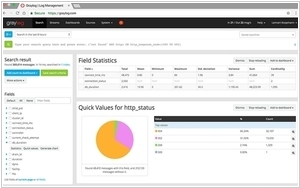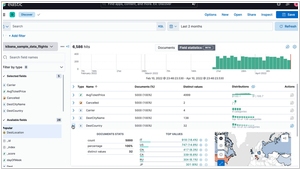Graylog vs Kibana
July 31, 2023 | Author: Michael Stromann
See also:
Top 10 SIEM software
Top 10 SIEM software
Graylog and Kibana are both popular log management and visualization tools, but they have distinct features and use cases. Graylog is an open-source log management solution that excels in centralized log collection, storage, and analysis. It offers robust search capabilities, streamlining the process of identifying and investigating issues within an organization's log data. Graylog also provides a user-friendly web interface for log exploration and analysis. Its focus on log management and real-time log processing makes it suitable for organizations seeking an efficient and cost-effective way to handle their log data.
On the other hand, Kibana is part of the Elastic Stack, and it is primarily a data visualization tool that works in conjunction with Elasticsearch. Kibana enables users to create interactive and customizable dashboards, charts, and graphs to visualize and analyze data stored in Elasticsearch. While Kibana does offer some log search capabilities, its primary strength lies in its data visualization and exploration features. It is well-suited for organizations that want to gain insights from diverse datasets and create visually appealing, interactive representations of their data.
Another key difference is their deployment models. Graylog is a standalone open-source solution that organizations can deploy on their own infrastructure. On the other hand, Kibana is part of the Elastic Stack, which includes Elasticsearch, a powerful search and analytics engine. This means that to use Kibana, organizations need to set up and manage an Elasticsearch cluster to store and index their log data, making it more suitable for organizations with more significant log data volumes and complex data visualization requirements.
See also: Top 10 SIEM software
On the other hand, Kibana is part of the Elastic Stack, and it is primarily a data visualization tool that works in conjunction with Elasticsearch. Kibana enables users to create interactive and customizable dashboards, charts, and graphs to visualize and analyze data stored in Elasticsearch. While Kibana does offer some log search capabilities, its primary strength lies in its data visualization and exploration features. It is well-suited for organizations that want to gain insights from diverse datasets and create visually appealing, interactive representations of their data.
Another key difference is their deployment models. Graylog is a standalone open-source solution that organizations can deploy on their own infrastructure. On the other hand, Kibana is part of the Elastic Stack, which includes Elasticsearch, a powerful search and analytics engine. This means that to use Kibana, organizations need to set up and manage an Elasticsearch cluster to store and index their log data, making it more suitable for organizations with more significant log data volumes and complex data visualization requirements.
See also: Top 10 SIEM software





